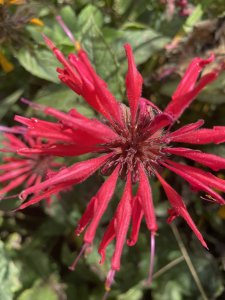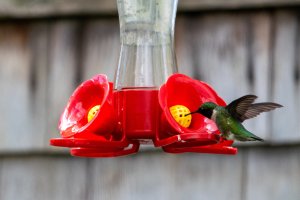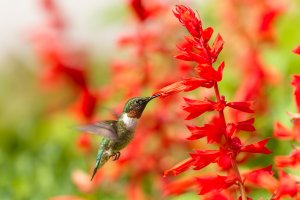Celebrate Michigan’s Tiniest Bird on National Hummingbird Day
September 4, 2024
By: Erin Parker, Interpretive Services Supervisor
Students returning to school, the first leaves beginning to turn, and a lot of activity at your backyard birdfeeders…autumn is inching closer.
The first of Michigan’s summer birds have already started heading south where they’ll find food and open water during our cold and icy winters. This time of year provides great opportunities to observe and enjoy our tiniest bird as they gather up at nectar sources in order to fuel their long-distance flights to the Gulf Coast and beyond.
Identifying and attracting hummingbirds
Michigan’s only resident hummingbird is the Ruby-throated. Ruby-throated hummingbirds can be recognized as adult males with their shiny red throat- but don’t be fooled, as the reflective red feathers can simply show up as black in the wrong light! Juvenile and female hummingbirds lack the ruby patch, but are a glossy green on their back and head with that distinctive, rapid, zipping flight from flower-to-flower or flower-to-feeder.

It is easy to beckon hummingbirds to your backyard or balcony with native nectar plants and hummingbird feeders. Hummingbirds are particularly attracted to tube-shaped flowers like columbines, beebalms, penstemons and red flowers like cardinal flower and paintbrushes.
Hummingbirds are also readily attracted to feeders. Humans can support healthy hummingbirds by keeping feeders clean (free of mold and fermented hummingbird nectar); only using plain white table sugar to avoid bacterial and fungal growth; don’t add red food coloring as real nectar is clear and the red dyes may harm the birds; and using a ratio of ¼ cup sugar to 1 cup water. Extra nectar solution can be stored in the fridge to reduce or delay fermentation. One trick to attract a lot of hummingbirds is to have feeders scattered throughout your yard or garden, as a single male hummingbird would be
Migration

Throughout the fall and even into the early days of winter, keep an eye out for the occasional western hummingbird- while ruby-throated hummingbirds are the only ones that spend their summers here, migration season occasionally sends a rufous or anna’s hummingbird our way- to the delight of birders and hummingbird lovers! Sometimes people are concerned that leaving their feeders out late in the season will keep the hummingbirds from completing their migration, but it turns out that many factors including day-length and temperatures send signals to these nectar-loving birds that they should start moving south. Late-season flowers and human-provided nectar just provide a little extra fuel for the stragglers before they take flight!
In the spring, our hummingbirds generally arrive in very late April through the first part of May, feeders out then can support their return…especially with the fluctuating weather conditions of Michigan’s spring. You can participate in a simple community science project by inputting your first sighting of a hummingbird each year into Journeynorth.org, or just follow along with the hummingbirds’ annual push north in the spring to determine when your feeders should get cleaned, filled, and ready for their arrival.
National Hummingbird Day
Each year since it was established in 1996, the first Saturday of September is designated as National Hummingbird Day. Created to raise awareness about hummingbirds and promote conservation of hummingbirds, National Hummingbird Day is a great opportunity for people to plant some native plants (or plan for next year’s garden) and consider adding a feeder or two to their backyard or balcony. This year, the holiday falls on Saturday, September 7th, and is about the same time that our resident hummingbirds are seeking to put on weight ahead of their big flights south.
Finding and photographing hummingbirds

Looking for hummingbirds to watch or photograph? Look for patches of blooming flowers, especially those tube-shaped and/or red flowers. Sunny days with little wind make the birds more active, and they’ll be fueling up (sometimes almost doubling in weight before they fly south) so look for feeding areas through mid-to-late September if the weather stays warmer and food remains readily available.
And this is a great time of year to consider adding their favorite native plants to your garden to bloom in time for next summer’s hummingbirds! Native plant sales are taking place throughout Michigan, and providing a diversity of blooms- from April through October- is a great way to support hummingbirds and other pollinators. Plants and seeds often establish well in the cooler fall weather, and our native plants benefit from the cold and freezing temperatures of winter. Get them planted before the first hard frost and you and your hummingbirds will celebrate come summer!
Resources and more reading
https://www.allaboutbirds.org/guide/Ruby-throated_Hummingbird/id
https://www.allaboutbirds.org/news/feeding-hummingbirds/
https://www.allaboutbirds.org/news/tiny-hummingbirds-incredible-migration/
